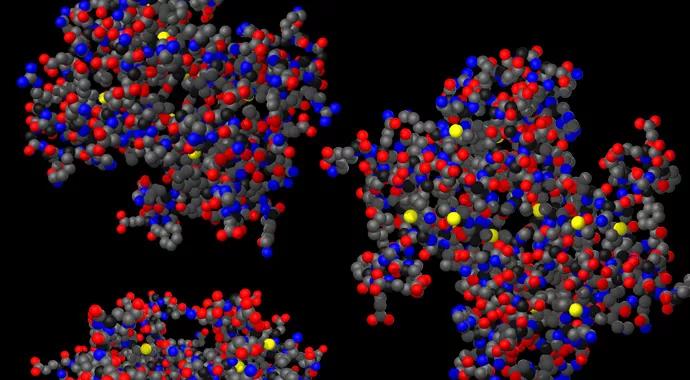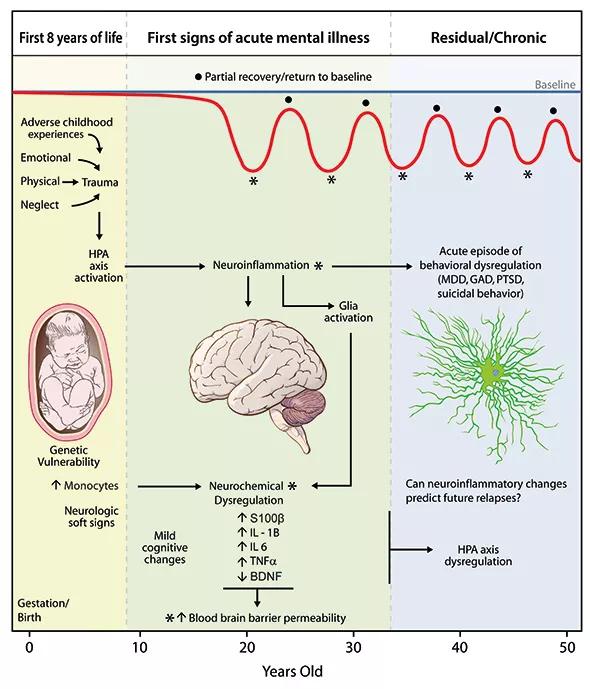Protein S100B may indicate blood-brain barrier disruption from severe psychological stress

Cleveland Clinic is a non-profit academic medical center. Advertising on our site helps support our mission. We do not endorse non-Cleveland Clinic products or services. Policy
A glial cell protein called S100B is a validated, reliable biomarker of blood-brain barrier (BBB) disruption and brain injury.1 In Europe, emergency departments are using a serum test for S100B to assess the severity of head injuries.
At Cleveland Clinic’s Neurological Institute, we have found evidence that S100B could be useful as a biomarker for BBB breakdown triggered by childhood trauma and abuse. If further validated, a serum test for S100B might become a clinical tool to assess the severity of emotional injury and the need for intervention.
Severe trauma during childhood has been linked to long-term mental health and social problems. In the 1990s, the Centers for Disease Control and Prevention and the Kaiser Permanente managed healthcare consortium launched the Adverse Childhood Experiences (ACE) Study, seeking links between childhood trauma and adult health. More than 17,000 adult health maintenance organization patients completed a questionnaire about childhood abuse (emotional, physical and sexual) and exposure to substance abuse, mental illness, domestic violence and other adverse experiences. These early life events were found to be strongly associated with suicidality, alcoholism, depressive disorders, illicit drug use and chronic medical diseases in adulthood.2-5
Similarly, children exposed to trauma in the first eight years of life have been shown to have a higher risk of developing mood disorders, psychotic disorders and posttraumatic stress disorder (PTSD), compared with children who were not exposed to trauma.6,7 Numerous studies have found associations between childhood maltreatment and other forms of trauma and subsequent alterations in brain development, particularly of the hippocampus and frontal cortex.8,9
Emotional trauma appears to be linked to neurobiological consequences, although the pathophysiologic mechanisms are not fully understood. Studies show that stress can activate an inflammatory response and impair BBB function. We and others10,11 have hypothesized that severe emotional trauma sets off a peripheral inflammatory response, leading to cytokine production, glial cell activation and BBB breakdown. These changes could potentially alter brain structure, cognition and behavior.
As a potential biomarker of CNS injury, S100B has been described as “the CRP (C-reactive protein) of the brain.”12 S100B is an astrocytic protein that can leak into the blood circulation when the BBB is breached. Elevated serum levels of S100B are not specific but have been associated with schizophrenia, bipolar disorder, depression, Alzheimer disease and epilepsy, as well as traumatic brain injury.
Our group first examined S100B as a potential biomarker of BBB function in suicidal adolescents with major depressive disorder and acute psychosis.13 A subscale of the Brief Psychiatric Rating Scale for Children (BPRS-C) quantified suicidality. Mean S100B values were 0.152 +/− 0.020 ng/mL in children with low suicidality (BPRS-C subscores 1 to 4), compared with 0.354 +/− 0.044 ng/mL in those with high suicidality (BPRS-C subscores 5 to 7). Compared with healthy controls, suicidal adolescents had significantly higher serum S100B levels (p < .05), independent of psychiatric diagnosis.
Recently, we used serum S100B as a biomarker to investigate whether childhood emotional trauma can alter the BBB.14 This study population included 88 psychiatric inpatients age 12 to 18 (64 with psychosis and 24 with mood disorder) and 20 healthy adolescent controls. A detailed psychiatric history and the Life Events Checklist (LEC) documented risk factors for childhood trauma, characterized as three types:
The LEC assesses exposure to sexual abuse or other unwanted sexual experience, natural disasters, emotional neglect, death in family, fire or explosion, serious accident, toxic substance, physical assault, assault with a weapon, combat, captivity, life-threatening illness, severe human suffering, violent death and serious injury.
We also collected blood samples for S100B analysis. The inpatients with childhood trauma showed increased S100B blood levels, independent of psychiatric diagnosis, compared with controls and inpatients with no trauma history. Among the 30 inpatients without childhood trauma, the mean LEC score was 3.6 and mean S100B was .150 ng/mL. The 58 adolescents who experienced childhood trauma had a mean LEC score of 11.71 (p < .0001) and mean S100B of .320 ng/mL (p = .001).
All trauma types — early, chronic and severe — were associated with increased S100B levels. Mean S100B levels showed a graded effect (one type, ~0.2 ng/mL; two types > 0.3 ng/mL; three types ~0.5 ng/mL). The healthy controls and inpatients without trauma exposure had a mean S100B < 0.2 ng/mL. We concluded that a history of childhood emotional trauma may be associated with BBB impairment in adolescent psychiatric patients.
This study, along with others, suggests that emotional trauma can cause long-term changes to the brain, possibly by way of an inflammatory response. The next step may be to use neuroimaging to compare levels of inflammatory markers with structural changes in the hippocampus or frontal lobe.
Of course, the most exciting potentiality would be to change the trajectory of a brain trauma so that intervention with medication or psychotherapy could prevent depression, psychosis or PTSD from developing.

Figure 1. Emotional trauma as a trigger for mental illness. During the first eight years of life, the impact of emotional trauma can trigger hypothalamic-pituitary-adrenal (HPA) axis dysregulation and increased inflammatory response (elevated monocytes). Monocytes can cross the blood-brain barrier (BBB). A more recent hypothesis suggests brain injury is caused by BBB disruption, leading to an influx of monocytes in the central nervous system. Activated monocytes can trigger neuroinflammation in glial cells and perpetuate cytokine and S100B production. Each traumatic episode triggers the inflammatory response and alters the BBB. When traumatic episodes occur early in life, they can alter brain development. Patients begin experiencing cognitive dysfunction, emotional lability and memory problems, probably related to increased BBB permeability.
Dr. Falcone is a staff member in Cleveland Clinic Neurological Institute’s Department of Psychiatry and Psychology and in the Epilepsy Center.
1. Babcock L, Byczkowski T, Mookerjee S, Bazarian JJ. Ability of S100B to predict severity and cranial CT results in children with TBI. Brain Inj. 2012;26(11):1372-1380.
2. Chapman DP, Anda RF, Felitti VJ, et al. Adverse childhood experiences and the risk of depressive disorders in adulthood. J Affect Disord. 2004;82:217-225.
3. Anda RF, Whitfield CL, Felitti VJ, et al. Adverse childhood experiences, alcoholic parents, and later risk of alcoholism and depression. Psychiatr Serv. 2002;53(8):1001-1009.
4. Dube SR, Anda RF, Felitti VJ, et al. Childhood abuse, household dysfunction, and the risk of attempted suicide throughout the life span: findings from the Adverse Childhood Experiences Study. JAMA. 2001;286:3089-3096.
5. Felitti VJ, Adanda RF, Nordenberg D, et al. The relationship of childhood abuse and household dysfunction to many of the leading causes of death in adults. Am J Prev Med. 1998;14(4):245-258.
6. De Bellis MD, Hooper SR, Woolley DP, et al. Demographic, maltreatment, and neurobiological correlates of PTSD symptoms in children and adolescents. J Pediatr Psychol. 2010;35(5):570-577.
7. Gil A, Gama CS, de Jesus DR, et al. The association of child abuse and neglect with adult disability in schizophrenia and the prominent role of physical neglect. Child Abuse Negl.2009;33(9):618-624.
8. Carrion VG, Weems CF, Reiss AL. Stress predicts brain changes in children: a pilot longitudinal study on youth stress, posttraumatic stress disorder, and the hippocampus. Pediatrics. 2007;119(3):509-516.
9. Carrion VG, Weems CF, Richert K, et al. Decreased prefrontal cortical volume associated with increased bedtime cortisol in traumatized youth. Biol Psychiatry. 2010;68(5):491-493.
10. Falcone T, Carlton E, Lee C, et al. Does systemic inflammation play a role in pediatric psychosis? Clin Schizophr Relat Psychoses. 2013:Mar 14:1-43 [Epub ahead of print].
11. Shalev H, Serlin Y, Friedman A. Breaching the blood-brain barrier as a gate to psychiatric disorder. Cardiovasc PsychiatryNeurol. 2009;2009:278531. Epub 2009 Aug. 27.
12. Sen J, Belli A. S100B in neuropathologic states: the CRP of the brain? J Neurosci Res. 2007;85;1373-1380.
13. Falcone T, Fazio V, Lee C, et al. Serum S100B: a potential biomarker for suicidality in adolescents? PLoS One. 2010;5(6):e11089.
14. Falcone T. Biomarkers for depression and schizophrenia: a progress update. Paper presented at: 11th World Congress of Biological Psychiatry; June 2013; Kyoto, Japan.

Real-world claims data and tissue culture studies set the stage for randomized clinical testing

New grant-funded investigation illustrates impact and reach of Cleveland Clinic Brain Study

How the new longitudinal investigation could become the Framingham Heart Study of brain health

Pilot findings show good patient acceptance and safety, early hints of efficacy

Study finds high prevalence of symptoms, willingness to seek treatment

Panel outlines research priorities around a promising alternative to imaging markers

Suspected factors include antithrombotic intensity, time on device, presence of thrombocytopenia

Preclinical studies will assess whether method developed for stroke recovery curbs deficits after brain injury